Non-government sources
In 2019–20, non-government sources spent $59.9 billion on health (Figure 17). At $29.8 billion (49.7%), individuals contributed nearly half of non-government health spending, private health insurance providers $16.7 billion (27.8%) and other non-government sources $13.5 billion (22.5%).
It is likely that the COVID-19 pandemic played an important role in lowering spending by individuals, private health insurance providers, and other non-government entities in 2019–20.
Figure 17: Estimated non-government health spending, constant prices⁽ᵃ⁾, by source of funds, 2009–10 to 2019–20
The line graph shows that spending by individuals increased each year and overall from $22.6 billion in 2009–10 to $29.8 billion in 2019–20. Spending by private health insurance funds also increased each year and overall from $11.2 billion in 2009–10 to $16.7 billion in 2019–20. Apart from the decrease in 2016–17, over the 10-year period other non-government spending increased overall from $8.3 billion in 2009–10 to $13.5 billion in 2019–20.
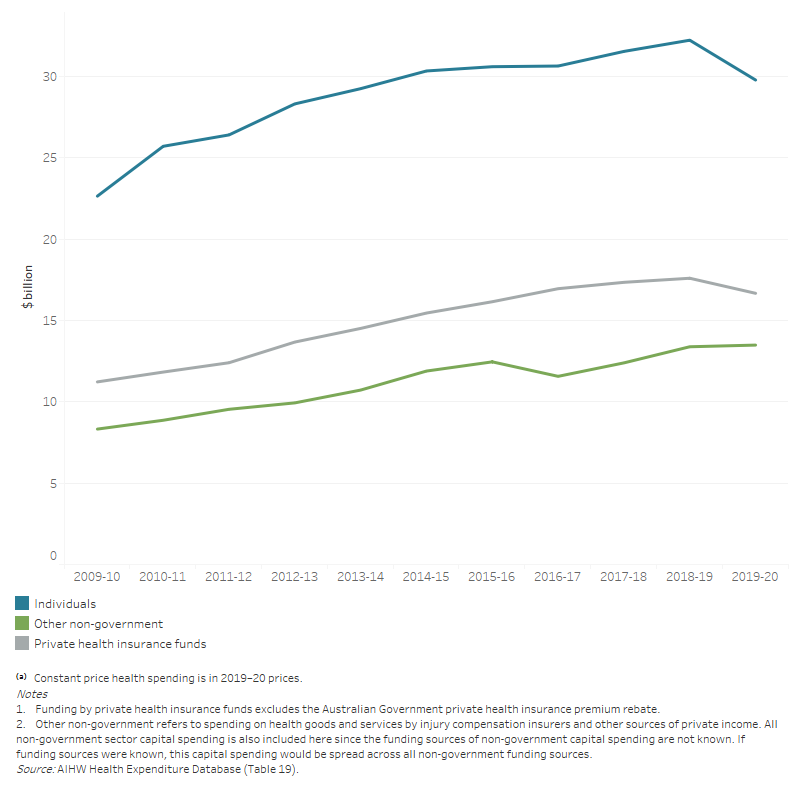
Individuals spent an estimate of $29.8 billion out-of-pocket on health goods and services in 2019–20. This was 7.6% less than in 2018–19.
In 2019–20, individuals spent an estimate of $11.0 billion (36.8%) on medications not subsidised through the PBS, including over-the-counter medications, vitamins and health-related products. Another $5.5 billion (18.5%) was spent on dental services and $4.1 billion (13.7%) on both referred and unreferred medical services (Table 20). Individuals’ spending on private hospitals declined by 33.7% compared to 2018–19, most likely due to the impacts of COVID-19.
Per person individual health spending
Health spending by individuals equated to an average of $1,165 per person in 2019–20.
This was made up of:
- $429 on non-subsidised medications
- $216 on dental services
- $160 on referred and unreferred medical services
- $109 on hospital services
- $106 on aids and appliances
- $63 on health practitioners, such as chiropractors, optometrists, practice nurses and physiotherapists
- $59 on medications partly subsidised by the PBS (Figure 18).
This annual per person spending decreased by 9.1% in 2019–20 in real terms, $117 less than in 2018–19. This was the slowest year of growth over the decade to 2019–20.
Figure 18: Estimated average⁽ᵃ⁾ per person individual health spending, by area of spending, constant prices⁽ᵇ⁾, 2009–10 to 2019–20
The line graph shows that per person health spending by individuals for hospitals, patient transport services, medical services, dental services, other health practitioners, community and public health, benefit-paid pharmaceuticals, all other medications and aids and appliances from 2009–10 to 2019–20. In 2019–20, per person health spending decreased for all areas of spending as compared to 2018–19. Over the 10-year period, per person health spending by individuals on all other medications increased by a relatively larger amount from $302 in 2009–10 to $436 in 2018–19 before decreasing to $429 in 2019–20. Per person spending by individuals on hospitals steadily increased from $111 in 2009–10 to $149 in 2018–19 before declining to $109 in 2019–20. Per person health spending by individuals on other practitioners increased from $102 in 2009–10 to $132 in 2012–13, and then decreased to $63 in 2019–20.
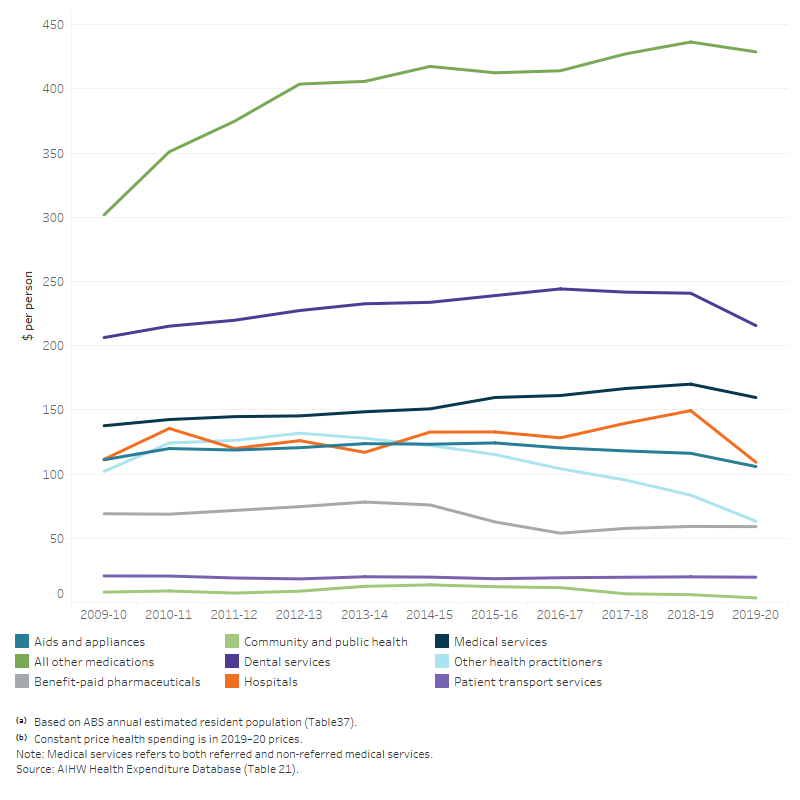
During 2019–20, providers of private health insurance financed $16.7 billion (8.2%) of total health spending. More than half ($9.5 billion) was for hospital services, with private hospitals receiving an estimated $8.6 billion. Approximately $2.8 billion was spent on primary health care services (Figure 19).
Spending by health insurance providers declined by 5.3% ($0.9 billion) in 2019–20 in real terms. This was the only year where there was a decline in growth over the decade to 2019–20, most likely due to the impact of the COVID-19 pandemic.
Figure 19: Private health insurance provider health spending by area of spending, constant prices⁽ᵃ⁾, 2009–10 to 2019–20
The line graph shows private health insurance provider health spending for public hospitals, private hospitals, primary health care, referred medical services and other services from 2009–10 to 2019–20. There was an overall decrease in private health insurance provider health spending for all areas of spending from 2018–19 to 2019–20. In 2019–20, private health insurance provider health spending on private hospitals, primary health care, other services, referred medical services and public hospitals were $8.6 billion, $2.8 billion, $2.7 billion, $1.7 billion and $0.9 billion respectively.
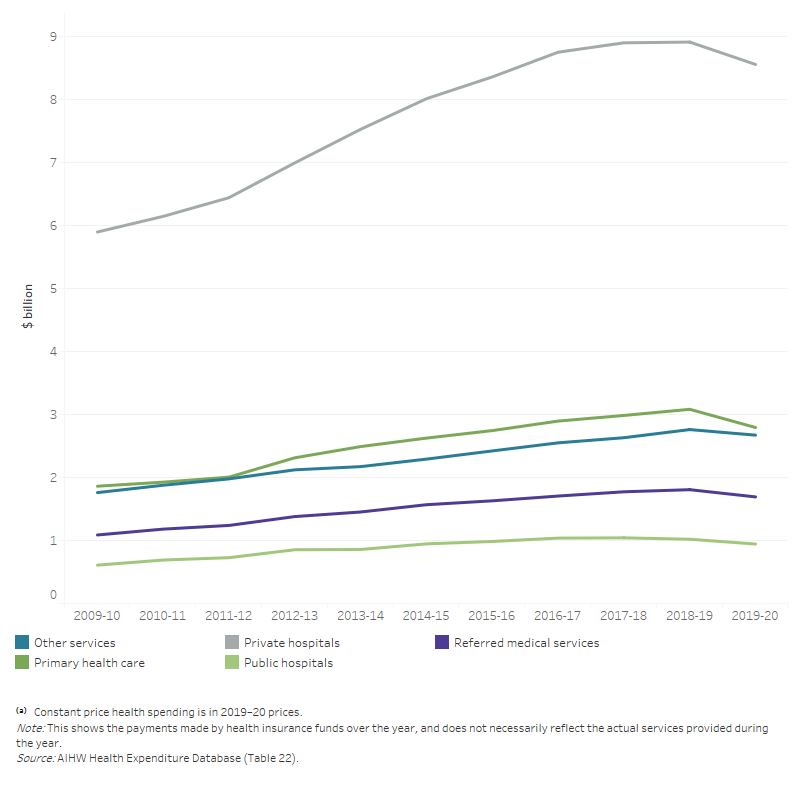
Private health insurance provider health spending per person covered
In 2019–20, private health insurance providers spent an estimated average of $1,485 per person covered by a private hospital insurance policy. This was a decrease of $80 (5.1%) from 2018–19 in real terms and was lower than the average annual growth of 2.7% per person covered over the decade (Figure 20).
South Australia ($1,721), Queensland ($1,618) and Tasmania ($1,603) had the highest spending by private health insurers per person covered, at more than 1.5 times the amount of the Northern Territory ($891) (Figure 20).
Nationally, spending by private health insurers equated to an average of $652 per person in 2019–20, including those not covered by private health insurance. This represented a decrease of 6.7% from 2018–19 in real terms. The average annual growth rate for the decade from 2009–10 was 2.4% (Table 24).
Figure 20: Average per person⁽ᵃ⁾ spending by private health insurance providers for each state and territory, constant prices⁽ᵇ⁾, 2009–10 to 2019–20
The line graph shows that average per person spending by private health insurance providers for all states and territories and Australia from 2009–10 to 2019–20. Over this period, average per person spending for all state and territories and Australia as the whole nation increased steadily every year to 2018–19 then decreased in 2019–20 except for South Australia. In 2019–20, average per person spending by private health insurance providers in New South Wales, Victoria, Queensland, Western Australia, South Australia, Tasmania and Australia as the whole nation was around $1,485. At the same time, average per person spending by private health insurance providers was $ 1,057 for the Australian Capital Territory and $891 for the Northern territory.
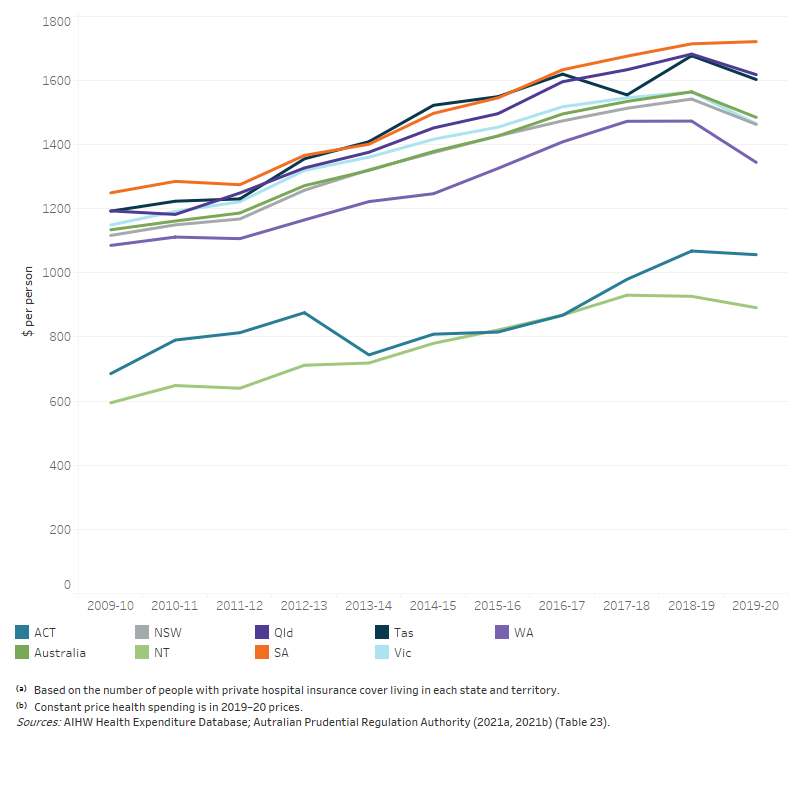
In 2019–20, other non‑government sources spent $13.5 billion on health, representing 6.7% of total health spending in the year (Table 10). This presented a slight increase of 0.8% compared with 2018–19, lower than the average annual growth rate over the decade (4.9%).
During 2019–20, injury compensation insurers spent $3.5 billion on health goods and services: $2.3 billion by workers’ compensation insurers and $1.2 billion by compulsory third‑party motor vehicle insurers (Table 25).
To better understand how health spending is impacting the disposable or readily accessible wealth of people (the ‘out-of-pocket costs’), the AIHW uses an amalgam of various components of non-government spending referred to as Personal health spending. It includes fees charged directly for services, some private spending in hospitals and donations for health research, but excludes expenses such as rebates from injury compensation insurers and private health insurance funds. In other words, it includes “Individuals” and “Other private sources” in the HED matrix (see the Australian National Health Account: concepts, methodology and data sourcesa sources and methodology for more details). Personal health spending is compared with both average incomes and measures of net worth to understand whether, on average across the population, out-of-pocket spending is rising relative to personal wealth over time. Note that these are average figures, so the analysis here does not take into account inequality issues in income, wealth, and personal health spending.
In 2019–20, personal out-of-pocket health costs amounted to an average of $1,556 per person, 2.3% of average annual income, a slight decline from 2018–19 (2.6%) (Figure 21).
Figure 21: Growth in average annual income⁽ᵃ⁾, average personal health spending per person⁽ᵇ⁾ and health spending to income ratio, current prices, 2009–10 to 2019–20
The line graph shows that annual growth rate in average individual health spending was positive for all years between 2009–10 and 2019–20 except in 2016–17 and 2019–20. In the 10- year period, annual growth rate in average individual health spending ranged from –5.6 per cent to 10.3 per cent. Growth rates in average annual income was positive each year in the 10- year period and ranged between 1.3 per cent and 6.7 per cent. The ratio between average individual health spending per person and average annual income was relatively flat with an average of 2.5 per cent.
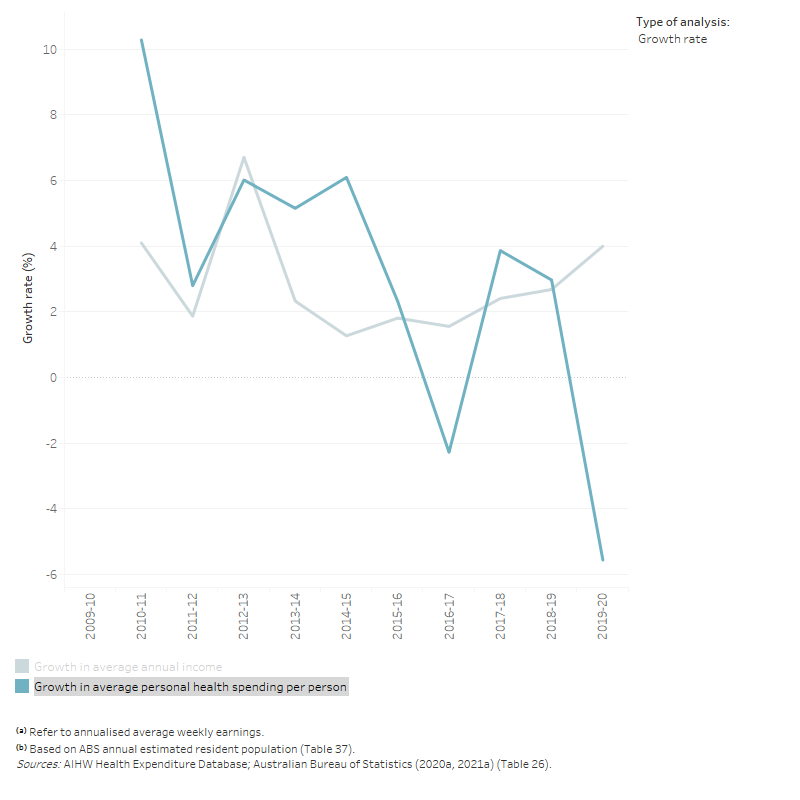
In 2019–20, personal spending on health represented on average 0.4% of individual net worth. This did not change much over the decade (Figure 22). On average, over the decade, per person net worth grew nominally by 4.0% per year, while per person personal health spending grew by 3.1% per year. In 2019–20, per person net worth grew by 3.0%, while per person personal health spending declined by 5.6% in nominal terms.
Figure 22: Growth in per person net worth, per person⁽ᵃ⁾ personal health spending and personal health spending to per person net worth ratio, current prices, 2009–10 to 2019–20
The line graph shows that both the growth rates in individual net worth and per person health spending by individuals fluctuated between 2009–10 and 2019–20. Annual growth rate in individual net worth was lowest at –0.9 per cent in 2011–12 before reaching its maximum rate at 9.8 per cent in 2014–15. Meanwhile, annual growth rate in per person health spending by individuals was lowest in 2019–20 at –5.6 per cent and highest in 2010–11 at 10.3 per cent. The ratio between per person health spending by individuals and individual net worth was relatively flat with an average of 0.4 per cent.
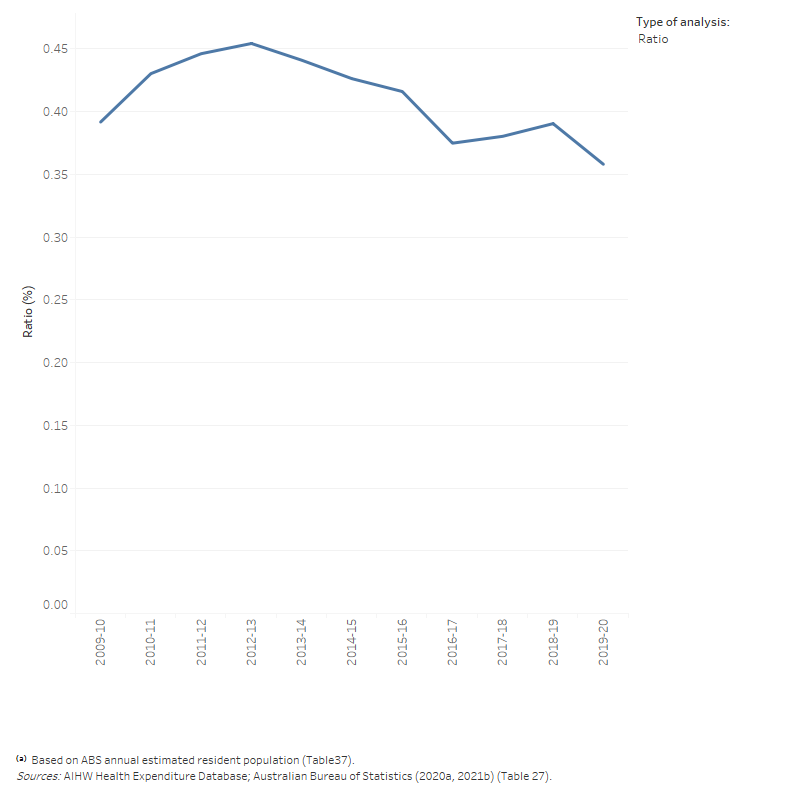
About measures of individual income and wealth
To estimate how personal health spending has compared with the financial resources available to individuals, 2 measures are considered:
- income is used to provide a sense of how health spending compared with average earnings throughout the year—how much was spent on health compared with how much earnt in that year
- net worth is used to provide a sense of how health spending compared with the overall wealth position of individuals in a given year, providing a more long-term sense of how health spending compared with personal wealth, particularly where health costs may be too high to be met by regular income.


